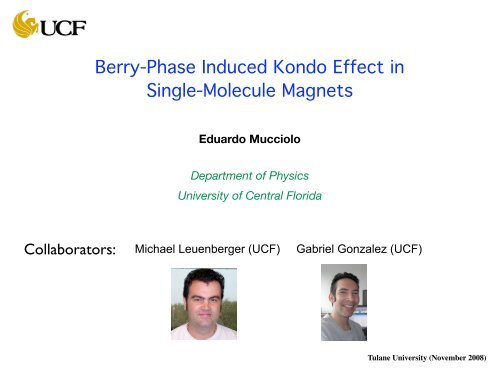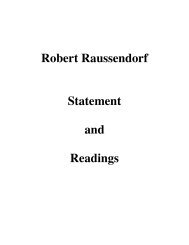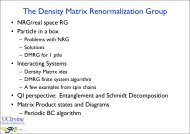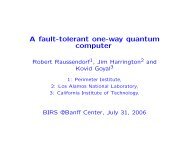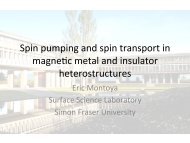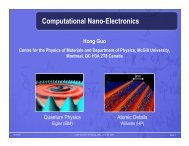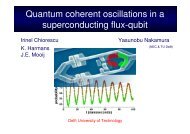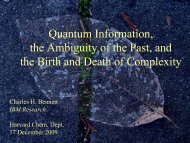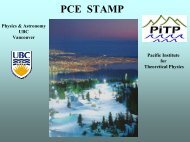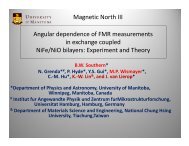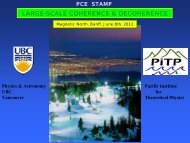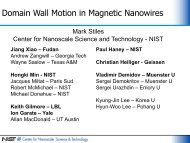Berry-Phase Induced Kondo Effect in Single-Molecule Magnets
Berry-Phase Induced Kondo Effect in Single-Molecule Magnets
Berry-Phase Induced Kondo Effect in Single-Molecule Magnets
You also want an ePaper? Increase the reach of your titles
YUMPU automatically turns print PDFs into web optimized ePapers that Google loves.
<strong>Berry</strong>-<strong>Phase</strong> <strong>Induced</strong> <strong>Kondo</strong> <strong>Effect</strong> <strong>in</strong>S<strong>in</strong>gle-<strong>Molecule</strong> <strong>Magnets</strong>Eduardo MuccioloDepartment of PhysicsUniversity of Central FloridaCollaborators: Michael Leuenberger (UCF) Gabriel Gonzalez (UCF)Tulane University (November 2008)
Overview- S<strong>in</strong>gle-molecule electronics- S<strong>in</strong>gle-molecule magnets:- <strong>Berry</strong>-phase blockade <strong>in</strong> s<strong>in</strong>gle molecules- <strong>Kondo</strong> effect <strong>in</strong> SMMs
S<strong>in</strong>gle-molecule electronics:molecular transistorelectrode(source)V gatemoleculeelectrode(dra<strong>in</strong>)1 - 10 nmV bias<strong>in</strong>sulated metal plate(gate)IPotential advantages:- fast operation- large energy scales (eV)- quantum effects at high temperatures ?!
Fabrication of the nano gaps:(Enrique del Barco, UCF)Electromigration and break<strong>in</strong>g of nanowires10Current (mA)8644K200.0 0.2 0.4 0.6 0.8 1.0 1.2 1.4Voltage (V)
Multiwire chip: Trial and error approach6µm70 nm
S<strong>in</strong>gle-electron transistors: What is actually measured?μ N < μ S , μ D < μ N+1E c +ΔEμ N+1μ Dμ Sμ D < μ N+1 < μ Sμ N+1μ Sμ S = μ N+1 = μ Dμ Dμ N+1μ SDμ Nμ N-1Sμ Dμ N-1Dμ NSDμ Nμ N-1Sno current(Coulomb blockade)f<strong>in</strong>ite currentwith f<strong>in</strong>ite biasf<strong>in</strong>ite current with(nearly) zero biasIdI/dVNN+1
Early experiments: Non magnetic moleculesNATURE | VOL 417 | 13 JUNE 2002 |www.nature.com/natureCoulomb blockade and the <strong>Kondo</strong>effect <strong>in</strong> s<strong>in</strong>gle-atom transistorsJiwoong Park*†‡, Abhay N. Pasupathy*‡, Jonas I. Goldsmith§,Connie Chang*, Yuval Yaish*, Jason R. Petta*, Marie R<strong>in</strong>koski*,James P. Sethna*, He´ctor D. Abrun˜a§, Paul L. McEuen* & Daniel C. Ralph** Laboratory of Atomic and Solid State Physics; and § Department of Chemistryand Chemical Biology, Cornell University, Ithaca, New York 14853, USA† Department of Physics, University of California, Berkeley, California 94720,USASeveral other groups around the world have also observed similar effects <strong>in</strong> molecular transistors
Our Motivation:How to <strong>in</strong>crease the functionality of a molecular transistor ?Comb<strong>in</strong>e electronics with magnetism:(i) Use magnetic molecules(ii) Use magnetic contacts
How do QTM and <strong>Berry</strong> phase <strong>in</strong>terferencemanifest themselves <strong>in</strong> electronic transportthrough a s<strong>in</strong>gle SMM?- Sp<strong>in</strong>-current blockade- <strong>Kondo</strong> effect
Recent experiments (Mn 12): Still not very conclusive...Herre van der Zant (Delft)Dan Ralph (Cornell)Enrique del Barco (UCF)No experiment has yetseen a unambiguousmanifestation of QTM,much less <strong>Berry</strong> phase<strong>in</strong>terference...
<strong>Kondo</strong> effect: The case of quantum dots and molecules attached to leadsAt low temperatures, sp<strong>in</strong> flip processes strongly renormalize the conductance<strong>in</strong>itial statevirtual (<strong>in</strong>termediate) statef<strong>in</strong>al stateSharp resonance at the Fermi level appears at T T 3!E FEEF
Another way of prob<strong>in</strong>g QTM: <strong>Kondo</strong> effectno Coulomb blockade!The <strong>Kondo</strong> effect <strong>in</strong> a non-magnetic s<strong>in</strong>gle-electron transistorhas already been observed by several groups...... but not yet for SMMs.
Unconventional <strong>Kondo</strong> effect <strong>in</strong> SMMs: How it happensM. Leuenberger and ERM [PRL 97, 126601 (2006)]S =mztS =m!12s = s =zztS =m!11U!1 +12z2z(!S = !1,z ! s z= +1)2~ t U<strong>in</strong>elastic( E m ≠ E m-1 )(suppressed at zero bias)S =m S =mz!12tS =m!1U12s = s =zztzz!12(!S = 0,~ztU2! s = 0) zelasticJ zno sp<strong>in</strong>flipp<strong>in</strong>gS =mzs =z!12tS z=m!121U!ES =!m+z1U12tS =!mz+1s z =2(!S = !2m, ! s = +1)~z2t !E2Uzelastic( E m = E -m )J ⊥sp<strong>in</strong>flipp<strong>in</strong>g
<strong>Kondo</strong> effect <strong>in</strong> SMMs: detailed theoryeffective HamiltonianH = H SMM + H <strong>Kondo</strong>H SMM = ∑ m ∗ E m ∗ |m ∗ 〉〈m ∗ |, E m ∗ = E −m ∗ [∆ m∗ ,−m ∗ (H ∗ x) = 0]H <strong>Kondo</strong> = ∑ k,α(ξ k + gµ BHxs ∗ )x2local exchange termψ † kα ψ kα + H exH ex = 1 2∑m∑ [j (m)+ Σ (m)k,k ′project it onto the {|m} subspace+ ψ † k↓ ψ k ′ ↑ + j (m)−Σ (m)−ψ † k↑ ψ k ′ ↓ + j z(m) Σ (m)z()]ψ † k↑ ψ k ′ ↑ − ψ † k↓ ψ k ′ ↓pseudo-sp<strong>in</strong> flipp<strong>in</strong>g termspseudo-sp<strong>in</strong> operatorsΣ (m)z(|m〉〈m| − | − m〉〈−m|)= 1 2Σ (m)± = | ± m〉〈∓m|anisotropic coupl<strong>in</strong>g constantsj (m)z= 2J z 〈m|S z |m〉j (m)± = J ± 〈±m|S ± | ∓ m〉
<strong>Kondo</strong> effect <strong>in</strong> SMMs: microscopic derivation of coupl<strong>in</strong>g constants !1EE(!1)s,m(!1)a,menergy levels relevantto the <strong>Kondo</strong> effect 0[]j z = ± 2t 2 U + ∆ 0U + ∆ 0(U + ∆ 0 ) 2 − ∆ 2 +1 (U − ∆ 0 ) 2 − ∆ 2 1[]j ⊥ = 4t 2 ∆ 1∆ 1(U + ∆ 0 ) 2 − ∆ 2 +1 (U − ∆ 0 ) 2 − ∆ 2 1|j z | ≫ j ⊥U2EE(0)a,m(0)s,m≈ ± 4t2U≈ 8t2 ∆ 1UU2 1q=!1 q=0 q=1anisotropic exchange <strong>in</strong>teraction!1!100(1)Ea,m1(1)E s,m1The sign depends onthe <strong>in</strong>termediate sp<strong>in</strong>state of the molecule!S 1 = S 0 − 1 2S 1 = S 0 + 1 2AFFM
<strong>Kondo</strong> effect <strong>in</strong> SMMs: poor man’s Renormalization Group!total Hamiltonian <strong>in</strong> projected subspaceH = ∑ m[E m(Σ (m)z) 2+ η (m) H ∗ xΣ (m)x]+ ∑ k,αξ k ψ † kα ψ k,α + H ex~DDEη (m) = 1 − νj(m) ⊥2Knight shiftmolecule’s pseudo-sp<strong>in</strong> couples to transversal fieldRenormalization Group flow equations...ζ = ln( ˜D/D)dj zdζ = −2ν j +j −dj ±dζ = −2ν j ±j z... and solutions1.5dηdζ = ν22 (j + + j − ) j zj 2 z − j 2 ⊥ = C > 0(√ )1C2ν √ C arctanh j z= ln( ˜DT K)! (T / T K)10.50-0.5H ∗ x −→ H ∗ x/η (m)˜D≈T-10 2 4 6 8 10T / T K
<strong>Kondo</strong> effect <strong>in</strong> SMMs: ConductanceL<strong>in</strong>ear conductance (T dependence)scatter<strong>in</strong>g amplitudeG(T ) = G 0∫dωA (m) ≈ j(m)ω≈ ˜D ⊥,ω≈ ˜D = √ C(− df ) π 2 ν 2dω 16[∑m e−E m/k B T |A (m) (ω)| 2∑m e−E m/k B T(ω/T K ) 2ν√ C(ω/T K ) 4ν√ C− 1]1st order perturbation theorys<strong>in</strong>gularity for T
<strong>Kondo</strong> effect <strong>in</strong> SMMs: <strong>Berry</strong> phase oscillations!The tunnel splitt<strong>in</strong>g is an oscillat<strong>in</strong>g function ofthe transverse magnetic field due to the <strong>Berry</strong>phase <strong>in</strong>terference.123Htwo-fold degeneracypo<strong>in</strong>ts (<strong>Kondo</strong> effect)H1< H 2 < H 3GConsequences:1) The <strong>Kondo</strong> peak splitt<strong>in</strong>g is a non-monotonicfunction of the transverse magnetic field.0eV2) The period of <strong>Berry</strong> oscillations is renormalized by the <strong>Kondo</strong> effect(strongly temperature dependent, with a universal function form).
<strong>Kondo</strong> effect <strong>in</strong> SMMs: Ni 4, the best candidate[Ni 4(ROH) 4L 4O 12] (R=Me,Et) Sieber et al. (2005)Sp<strong>in</strong> tunnel<strong>in</strong>g splitt<strong>in</strong>g Δ (numerical simulations)=!E S,-S(H ) [K]10 010 -110 -210 -310 -4" = 34 #T / T K= 2T / T K= 3T / T K= 10!E S,-S(H ) [K]10 010 -110 -210 -310 -4" = 41 #0 1 2 3 4 5 6 7H [T]
Some estimates (Ni 4):M. Leuenberger and ERM [PRL 97, 126601 (2006)]T K ≈ D exp[ (√ )−arctanh C/jz /2ν √ ]Cν(J z − J ± ) ≈ 0.15∆E = D = ∣ ∣A [ S 2 − (S − 1) 2]∣ ∣ ≈ 9.3 KT K ≈ 1.2 K (m = ±4)crucial requirements:i) large sp<strong>in</strong> tunnel splitt<strong>in</strong>gii) large coupl<strong>in</strong>g to states <strong>in</strong> the leadsissues under <strong>in</strong>vestigation:i) quantitative theory for transport (NRG, DMRG?)ii) sp<strong>in</strong>/angular momentum relaxation <strong>in</strong> isolated moleculesSee also related work by the Aachen group (H. Schoeller).
Some Questions and Challenges for the STM group:(1) How does the SMM b<strong>in</strong>d to metallic surfaces?(2) Where does the additional electron go <strong>in</strong> a SMM?chemistry/electronic structure(3) Can the SMM be manipulated by the SMT tip?(move it, flip it, and extract or modify ligands)technical challenge(4) Does the tip position change the electric responseof the SMM?(5) Can a SP-STM measure the magnetization curve ofa SMM (quantum tunnel<strong>in</strong>g, coherent oscillations,decoherence)?physicsSP!tipSMMmagnetic islandnonmagnetic substrateSMMs have <strong>in</strong>tr<strong>in</strong>sically largemagnetization and stronganisotropy, so a magneticisland may not be necessary.
The End


